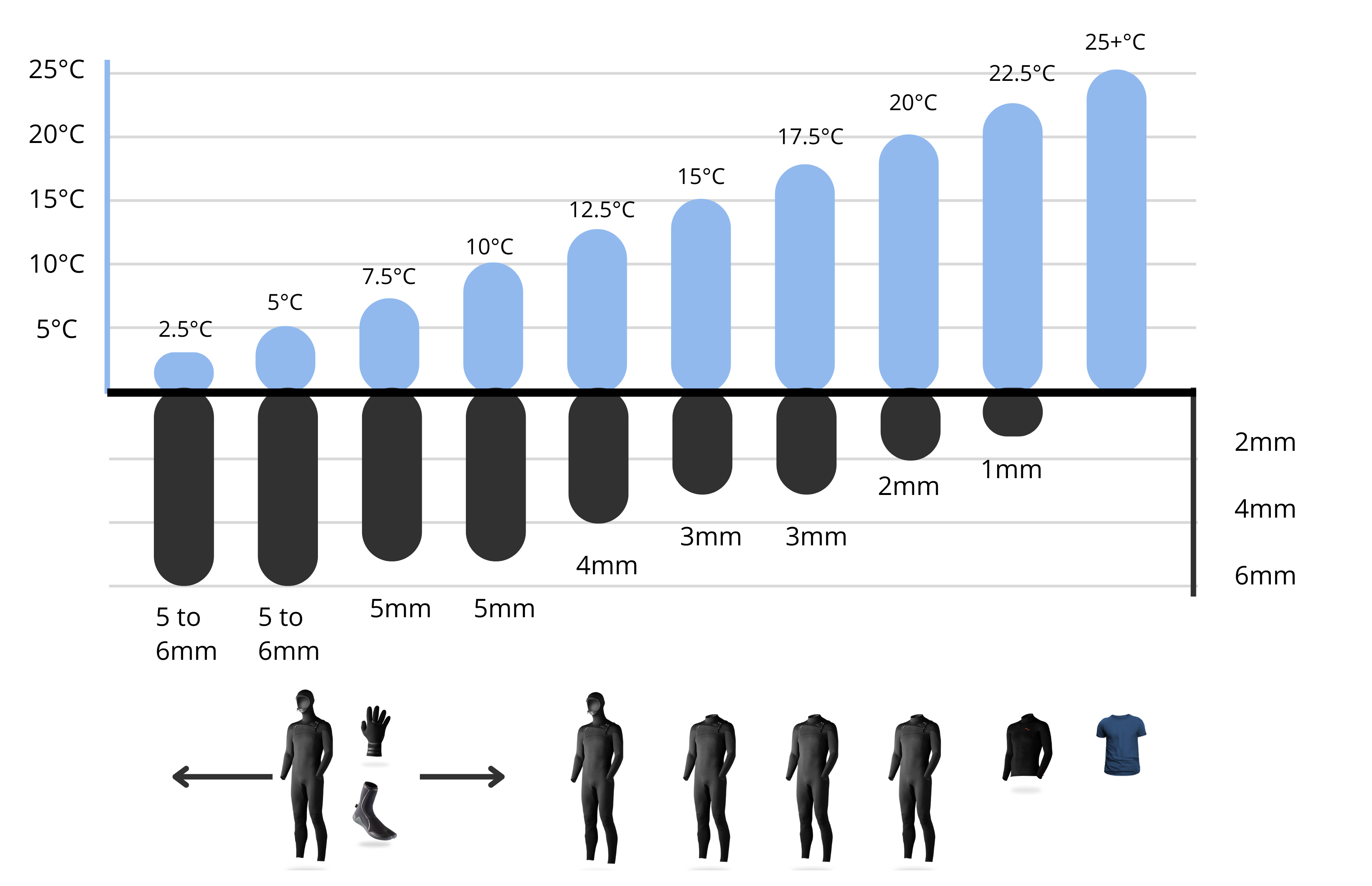Choosing the right wetsuit is essential for enjoying your surf sessions in comfort, especially when tackling the fresh waters of Portugal, cold waters of the UK, Scandinavia and the North Sea.
For France, you can read the wetsuit guide especially for surfing in France.
This guide will help you determine which wetsuit is best for your needs based on water temperatures, as well as provide tips on purchasing, fitting, and even repairing your wetsuit.
Understanding Wetsuit Thickness & Water Temperature
Selecting the right wetsuit thickness depends heavily on the water temperature you’ll be surfing in. The following guide offers a general rule of thumb for staying warm and comfortable, whether you’re surfing in colder waters or traveling to warmer climates.
Water Temperature & Wetsuit Guide
In the Netherlands, the water temperature varies significantly throughout the year, making it crucial to choose the right wetsuit thickness for each season. Below is a handy chart and graph that illustrate the appropriate wetsuit thickness based on water temperature by month.

Wetsuit Thickness by Type
Shorty (2mm)
A shorty wetsuit leaves your forearms and legs exposed, and is typically around 2mm thick. It’s ideal for warm water temperatures above 20°C, making it a rare choice for the colder countries. There, you might find it useful only during the warmest summer days in July or August.
3/2 mm Wetsuit
The 3/2mm wetsuit is perfect for surfing in many countries in Europe, the Netherlands from May to September. But also in France during the beautiful summer morning. It offers full-body coverage and provides the necessary flexibility for moderate water temperatures.
4/3 mm Wetsuit
A 4/3mm wetsuit serves as an intermediate option, ideal for early spring or autumn when the water is cooler. It’s also wearable during warmer winter days for some surfers.
5/4 mm Wetsuit
This is your go-to winter wetsuit for colder waters as in the UK, the Netherlands and Scandinavia. A hood is optional but highly recommended. Some wetsuits come with an integrated hood, while others offer it as a separate accessory. Gloves and booties are essential for winter surfing as well.
Even a 6/5 mm is your best choice going surfing up North.
But, what is a Wetsuit?
A wetsuit is a specially designed garment made from neoprene, a synthetic elastic rubber, that helps to retain body heat in cold water. The wetsuit traps a thin layer of water between your skin and the suit, which your body heats up, keeping you warm.
Wetsuits come in various thicknesses to suit different water temperatures, as discussed above.
Wetsuit Buying Tips
Choosing the right wetsuit involves more than just thickness. Here’s what to consider when buying:
- Flexibility: The more stretch a wetsuit has, the more comfortable it will be. Higher flexibility often comes with a higher price tag, but it’s worth it for improved mobility and comfort.
- Seams: Look for wetsuits with taped seams, as these prevent water from seeping in and offer better insulation.
Price Range for Wetsuits
Depending on the thickness, materials, and brand, expect to pay the following prices for a quality wetsuit:
| Wetsuit Type | Price Range |
|---|---|
| 2mm Shorty | €125 – €175 |
| 3/2mm Full Wetsuit | €175 – €250 |
| 4/3mm Full Wetsuit | €200 – €300 |
| 5/4mm Full Wetsuit | €275 – €450+ |
Investing in a well-made wetsuit is worth it for durability, warmth, and comfort.
Wetsuits from previous seasons or with lower quality materials may be available for less, but investing in a well-made suit is advisable for durability and warmth.
Wetsuit Reviews
We’ve recently tested two wetsuits from SRFACE and Decathlon, both of which are affordable options. Here’s a quick comparison:
- Decathlon wetsuits offer good value for money and performed well in our tests.
- SRFACE wetsuits are exclusively sold online, allowing them to cut out middlemen and keep prices lower while maintaining high quality. The SRFACE Remix is our favorite.
Women’s Wetsuits
Women’s wetsuits are specifically designed to fit the female body, with a wider cut at the hips and chest and a narrower waist. It’s important for women to try on wetsuits before purchasing to ensure a proper fit, as wearing a men’s suit will lead to discomfort and inadequate warmth.
Fun Wetsuit Facts
Jack O’Neill Didn’t Invent the Wetsuit! Though often credited with its invention, it was actually his brother Robert who developed the first designs. Jack O’Neill later co-founded the successful O’Neill brand in Santa Cruz, California.
Peeing in Your Wetsuit Many surfers admit to peeing in their wetsuit during colder sessions—it’s not as bad for the suit as you’d think. Just make sure to rinse your suit thoroughly after surfing!
Wetsuit Repair
Got a tear in your wetsuit? Don’t worry—you can easily repair it yourself! Here’s a simple step-by-step guide for repairing small to medium-sized tears:
- Clean and dry the damaged area.
- Apply a thin layer of wetsuit glue to the edges of the tear.
- Wait for the glue to dry slightly, then apply a second layer.
- Press the edges together and hold them under pressure for a few minutes.
- Let the suit dry for 10 minutes before using it again.
Custom-Made Wetsuits
If you have trouble finding a standard size, you can always have a wetsuit custom-made. Snugg Wetsuits in Cornwall has been crafting high-performance wetsuits since 1982 and specializes in custom fits to keep you warm in the water.
By following this guide, you’ll be well-equipped to choose the right wetsuit, whether you’re surfing in the chilly waters of the North Sea or heading to warmer destinations!






